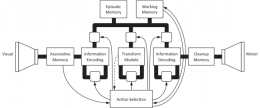November 30, 2012 report
Spaun, the new human brain simulator, can carry out tasks (w/ video)

(Phys.org)—One of the challenges of understanding the complex behavior of animals is to relate the behavior to the complex processes occurring within the brain. So far, neural models have not been able to bridge this gap, but a new software model, Spaun, goes some way to addressing this problem.
The Semantic Pointer Architecture Unified Network (Spaun) is a computer model of the human brain built by Professor Chris Eliasmith and colleagues of the University of Waterloo in Canada. It comprises around two and a half million virtual neurons organized into functional groups rather like real neurons in regions of the human brain associated with vision, short-term memory, and so on. (The human brain has roughly 100 billion neurons.)
Spaun is presented with a sequence of visual images in eight separate tasks. It then processes the information presented to it and then decides what action to take. It can recognize and remember numbers written in different handwriting, and can copy them using a mechanical arm. Spaun can also answer questions about numbers and complete number series after seeing examples.
These tasks are simple, but they capture many features of neuroanatomy and physiology, including abilities to perceive, recognize and carry out required behaviors. They also require an enormous amount of computing power, with the computer needing two hours of processing time for each second of Spaun simulation.
The most surprising feature about Spaun, according to Prof. Eliasmith and colleagues is that it has human-like flaws. For example, it has trouble remembering lists of numbers when they are too lengthy, and is better at remembering numbers at the beginnings and ends of lists. It also hesitates before answering questions, just as humans do. These flaws may be useful in future robots, Eliasmith said, as they would make robots seem more human-like and therefore easier to interact with.
Eliasmith said Spaun is the first simulator of the brain to be able to complete a series of tasks and demonstrate behaviors, even though bigger brain models have been built in the past, such as that built by the Blue Brain Project, with a million neurons, and SyNAPSE (IBM) with a billion simulated neurons.
Spaun is more similar to the human brain than previous models, Eliasmith said, and it could therefore be used in the study of some brain disorders. In a recent experiment, for example, he examined the effects of neurons "dying off," in a simulation of aging of the human brain; an experiment that would have been unethical if using human subjects. The model might also be useful in the development of multi-task artificial intelligence applications, and robotics.
Spaun does have its limitations because at present it can only carry out the tasks given it and cannot learn anything new, and because of its lengthy computer processing time.
The research paper was published in the journal Science.
More information: A Large-Scale Model of the Functioning Brain, Science 30 November 2012: Vol. 338 no. 6111 pp. 1202-1205. DOI: 10.1126/science.1225266
ABSTRACT
A central challenge for cognitive and systems neuroscience is to relate the incredibly complex behavior of animals to the equally complex activity of their brains. Recently described, large-scale neural models have not bridged this gap between neural activity and biological function. In this work, we present a 2.5-million-neuron model of the brain (called "Spaun") that bridges this gap by exhibiting many different behaviors. The model is presented only with visual image sequences, and it draws all of its responses with a physically modeled arm. Although simplified, the model captures many aspects of neuroanatomy, neurophysiology, and psychological behavior, which we demonstrate via eight diverse tasks.
Download the Spaun model
Videos for Spaun simulations
Press release
Journal information: Science
© 2012 Phys.org

















